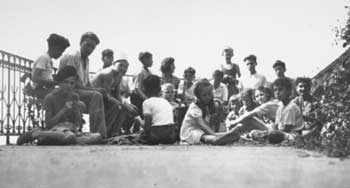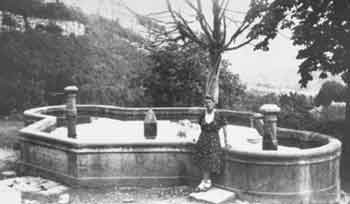Jewish Victims of the Holocaust: The Children of Izieu
The remote mountain village of Izieu overlooks the Rhone river between Lyon and Chambery in central France. In 1943, a children’s home was opened in Izieu as a refuge for Jewish children threatened with arrest and deportation during the German occupation of France. It was established in an empty farm house by a former Red Cross nurse, Sabina Zlatin, who co-directed the home with her husband Miron.
The original group of children that lived in the Izieu home were transferred from the Palavas-les-Flots OSE center and the Campestre à Lodève home (both in the Hérault), which had recently been closed. Although the Izieu home was independently operated, the Zlatins received a stipend for each child from the Œuvre de Secours aux Enfants (Society for Assistance to Children - OSE).
The Jewish children, aged between five and seventeen, felt safe and secure, supervised by seven adults.
 At the children's home in Izieu |
On the morning of April 6, 1944, a French holicay, they all settled down in the refectory to drink hot chocolate. Three vehicles, two of which were lorries, pulled up in front of the home. The Gestapo, led by the “Butcher of Lyon” Klaus Barbie, entered the home and forcibly removed the forty-four children and their seven supervisors, throwing the crying and terrified children on to the trucks like sacks of potatoes.
As a witness later recalled: “I was on my way down the stairs when my sister shouted to me: ‘It’s the Germans, save yourself!’ I jumped out the window. I hid myself in a bush in the garden. I heard the cries of the children that were being kidnapped and I heard the shouts of the Nazis who were carrying them away.”
Only one person, Léon Reifman, was able to escape. Sabina Zlatin was away at the time, having gone to Montpellier to arrange for the transfer of the children to a safer location.
The following day, Barbie boasted of his accomplishment: “This morning the Jewish children’s home ‘Children’s Colony’ in Izieu-Ain was liquidated. Altogether 41 children aged three to thirteen were arrested. Furthermore, it was possible to arrest the whole Jewish staff consisting of ten persons, including five women. Cash or other valuables could not be seized.”
The document, signed SS-Hauptsturmfuhrer Alois Brunner, also said they would all be transported to Drancy on April 7, 1944.
Following the raid on their home in Izieu, the children were taken to the Fort Montluc prison in Lyon. The following day they were transported by train to the “collection center” in Drancy, then put on the first available transport toward the death camps in the east.
Forty-two children and five adults were gassed at Auschwitz. two of the oldest children and Miron Zlatin, the superintendent, ended up in Tallin, in Estonia, and were executed by a firing squad.
One survivor of Auschwitz revealed during Barbie’s trial what happened to the children:
 Lea Feldblum poses next to the fountain at the children's home in Izieu |
In Izieu a young French woman, Renee Paillares, an aide at the children’s home in Izieu, succeeded in hiding the three-year-old Jewish refugee child Diane Popowski in her home. The little child, born in 1940 in Luxembourg, survived the Holocaust.
These are the children from Izieu and their seven supervisors. Lea Feldblum, 27, was the sole survivor./lyons
|
Sami Adelsheimer, 5
Hans Ament, 10
Nina Aronowicz, 12
Max-Marcel Balsam, 12
Jean-Paul Balsam, 10
Esther Benassayag, 12
Elie Benassayag, 10
Jacob Benassayag, 8
Jacques Benguigui, 12
Richard Benguigui, 7
Jean-Claude Benguigui, 5
Barouk-Raoul Bentitou, 12
Majer Bulka, 13
Albert Bulka, 4
Lucienne Friedler, 5
Egon Gamiel, 9
Maurice Gerenstein, 13
Liliane Gerenstein, 11
Henri-Chaïm Goldberg, 13
Joseph Goldberg, 12
Mina Halaunbrenner, 8
Claudine Halaunbrenner, 5
Georges Halpern, 8
Arnold Hirsch, 17
Isidore Kargeman, 10
|
Renate Krochmal, 8
Liane Krochmal, 6
Max Leiner, 8
Claude Levan-Reifman, 10
Fritz Loebmann, 15
Alice-Jacqueline Luzgart, 10
Paula Mermelstein, 10
Marcel Mermelstein, 7
Theodor Reis, 16
Gilles Sadowski, 8
Martha Spiegel, 10
Senta Spiegel, 9
Sigmund Springer, 8
Sarah Szulldaper, 11
Max Tetelbaum, 12
Herman Tetelbaum, 10
Charles Weltner, 9
Otto Wertheimer, 12
Emile Zucherberg, 5
Lucie Feiger, 49
Mina Friedler, 32
Sarah Levan-Reifman, 36
Eva Reifman, 61
Moïse Reifman, 63
Miron Zlatin, 39
|
Sources: Children of Izieu.
Photos: U.S. Holocaust Memorial Museum.
Recommended Reading:
French Children of the Holocaust: A Memorial, by Serge Klarsfeld. New York University Press.
The Children of Izieu: A Human Tragedy, by Serge Klarsfeld. New York, Abrams: 1984.


